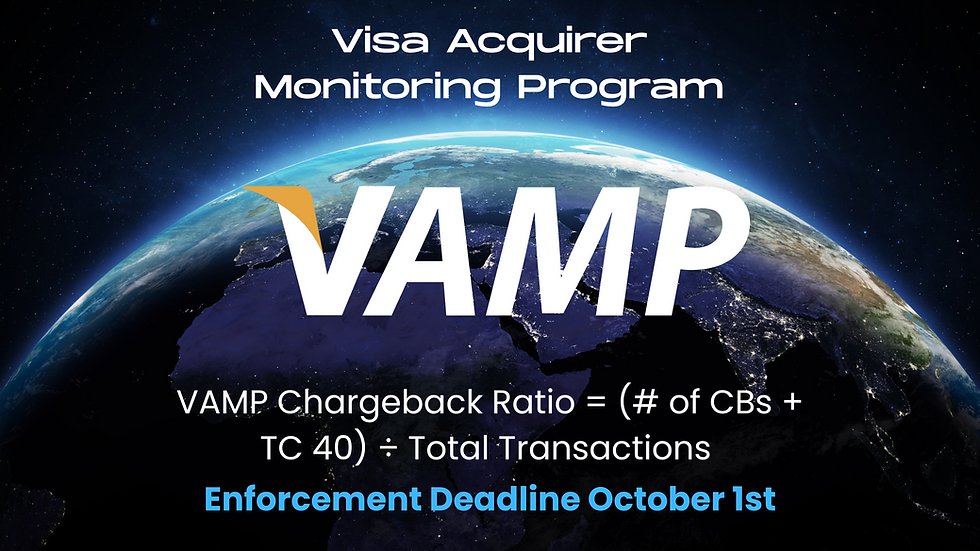VAMP: What Every Merchant Needs to Know
- Trevor Johnson
- Aug 4
- 4 min read
Compaytence Brief: August 4th, 2025
Beginning October 1, 2025, Visa will initiate full enforcement of its Acquirer Monitoring Program (VAMP), a comprehensive overhaul of its fraud and dispute oversight framework. This program consolidates prior monitoring systems (VDMP and VFMP) into a single regime that applies heightened scrutiny to all card-not-present (CNP) transactions.
Merchants identified as exceeding VAMP thresholds will face immediate and escalating penalties, including a $10 fee per chargeback, reserve increases, delayed settlement of funds, and potential account freezes. In many cases, processors may terminate merchants without notice to mitigate portfolio-level risk. The ability to process Visa transactions — which account for nearly 40% of global card volume — may be suspended entirely.
Enforcement will not be preceded by individual warnings or extensions. Merchants must achieve compliance prior to the deadline. Those failing to act will be exposed to reputational damage, financial loss, and operational disruption.
Compliance preparation is no longer optional. Merchants must proactively review risk metrics, optimize chargeback mitigation strategies, and ensure their VAMP ratio remains within acceptable limits.
A Unified Compliance Framework: Simpler, but Stricter
As of April 2025, Visa retired both the Visa Dispute Monitoring Program (VDMP) and the Visa Fraud Monitoring Program (VFMP). In their place comes VAMP, a unified model that introduces a consolidated risk ratio and tightens oversight across the board.
“This is part of Visa’s effort to clean up the payment ecosystem by holding acquirers and their merchants accountable for excessive risk and poor practices.” — The Ultimate Guide to VAMP, Compaytence & Disputifer
Here’s the new reality:
VAMP monitors a combined ratio of disputes and fraud alerts, known as TC15s and TC40s.
Transactions flagged by Rapid Dispute Resolution (RDR) or Compelling Evidence 3.0 (CE3.0) may be excluded, but fraud alerts (TC40s) often remain—even when disputes are resolved early.
Enumeration fraud (a.k.a. card testing) is now measured via a separate enumeration ratio, powered by Visa’s new AI-driven VAAI system.

What Counts in the VAMP Ratio?
The VAMP ratio is calculated as:
(All Disputes + TC40 Fraud Alerts) ÷ Total Settled CNP Transactions
This ratio is now double-counting fraud-related disputes in many cases — once as a TC40 and once as a dispute — meaning that even well-managed merchants may see a sharp increase in reported rates.
The new thresholds:
Role | "Excessive" Threshold | Changes Coming |
Merchants | 1.5% (Oct 1) → 0.9% (Jan 1 2026 with fraud related transactions) | Enforcement begins October 1, 2025 |
Acquirers | 0.5% (Excessive), 0.3% (Above Standard) | Penalties start January 2026 |
If your business breaches these levels for more than one month, you’ll be enrolled in VAMP and face $10 per chargeback — even if the cardholder’s dispute is resolved or unfounded.
Who’s Most at Risk?
Subscription and trial-based merchants
CBD, nutraceuticals, gaming, adult, or dropshipping verticals
High-volume or cross-border sellers
Merchants without real-time alert systems (Ethoca, Verifi, CDRN)
Businesses with weak refund or billing transparency
5 Actions to Protect Your Business Now

1. Implement Real-Time Alerts
Use a tri-layered system for complete dispute interception:
Ethoca for Mastercard (and some Visa)
Verifi RDR for real-time Visa alerts
CDRN for long-tail banks and international issuers
Set Up Alerts Now through Disputifer — get coverage across all three platforms in one place.
2. Fix Your Policies
Align your customer experience and billing practices with industry best practices:
Transparent refund and cancellation terms
Billing descriptors that match your brand
Pre-bill subscription reminders
Clear FAQ and support escalation paths
Compaytence offers CX audits to spot policy weak points before they become chargebacks.
3. Dissect Your Chargeback Data
Break down your disputes by type:
True fraud → add 3DS, CVV/AVS, IP filters, BIN checks
Merchant error → fix fulfillment workflows
Friendly fraud → improve documentation and alerts
Use Disputifer to visualize disputes by SKU, campaign, processor, and geography, helping you pinpoint problem segments fast.
4. Reinforce Fraud Defenses
Even if a chargeback is reversed in your favor, it still damages your Chargeback Ratio.
Deploy velocity checks by card, IP, and device
Leverage geolocation and proxy detection
Implement 3DS2 (mandatory in the EU/UK)
Use device fingerprinting and dynamic BIN profiling
Need help choosing the right tools for your market? Book a strategy call with Compaytence for a custom fraud stack review.
5. Elevate Your Customer Service
Poor CX = “fraud” in the data. Prevent disputes with:
Real-time chat and clear return processes
Post-purchase surveys and satisfaction outreach
Prompt tracking updates and billing confirmations
Merchants who invest here see 30–70% fewer chargebacks within 60 days, according to internal Compaytence benchmarks.

Why It’s Urgent — and Where We Come In
“Merchants will face not just network fees but also reputational risk with banks and processors. VAMP penalties can escalate to account closures and Visa bans.” — VAMP Guide, Compaytence
If you’re unsure where your current ratios stand — or if you’ll be affected when enforcement begins — now is the time to act.
At Compaytence, we specialize in:
Chargeback mitigation strategies
Merchant-processor relationship recovery
Payment stack optimization
Risk modeling & enumeration detection
Pre- and post-VAMP compliance
Watch our 5-minute explainer video, Download the full VAMP Compliance Guide, Join the Compaytence Academy for advanced merchant training.
All available at compaytence.com
Final Word: Don’t Wait Until You’re Flagged
Visa’s VAMP program represents the most significant shift in fraud and dispute monitoring in a decade. And while it targets acquirers in name, merchants will pay the price in practice — financially and operationally.
Use this advisory period wisely. Review your ratios, audit your funnel, and if needed, bring in a trusted consulting partner to get ahead of the curve.
October 1, 2025 is just around the corner. If you're still guessing your VAMP status, you're already behind.
Need help navigating VAMP?
Book a 1:1 call with Compaytence or email us at marketing@compaytence.com
Written by Trevor Johnson




Comments